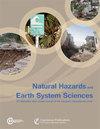Mangrove ecosystem properties regulate high water levels in a river delta
IF 4.7
2区 地球科学
Q1 GEOSCIENCES, MULTIDISCIPLINARY
引用次数: 2
Abstract
Abstract. Intertidal wetlands, such as mangroves in the tropics, are increasingly recognized for their role in nature-based mitigation of coastal flood risks. Yet it is still poorly understood how effective they are at attenuating the propagation of extreme sea levels through large (order of 100 km2) estuarine or deltaic systems, with complex geometry formed by networks of branching channels intertwined with mangrove and intertidal flat areas. Here, we present a delta-scale hydrodynamic modelling study, aiming to explicitly account for these complex landforms, for the case of the Guayas delta (Ecuador), the largest estuarine system on the Pacific coast of Latin America. Despite coping with data scarcity, our model accurately reproduces the observed propagation of high water levels during a spring tide. Further, based on a model sensitivity analysis, we show that high water levels are most sensitive to the mangrove platform elevation and degree of channelization but to a much lesser extent to vegetation-induced friction. Mangroves with a lower surface elevation, lower vegetation density, and higher degree of channelization all favour a more efficient flooding of the mangroves and therefore more effectively attenuate the high water levels in the deltaic channels. Our findings indicate that vast areas of channelized mangrove forests, rather than densely vegetated forests, are most effective for nature-based flood risk mitigation in a river delta.红树林生态系统特性调节河流三角洲的高水位
摘要潮间带湿地,如热带地区的红树林,在以自然为基础减轻沿海洪水风险方面的作用日益得到承认。然而,它们在通过大型(约100平方公里)河口或三角洲系统(由与红树林和潮间带区交织在一起的分支水道网络形成的复杂几何结构)减弱极端海平面传播方面的效果如何,人们仍然知之甚少。在这里,我们提出了一个三角洲尺度的水动力模拟研究,旨在明确地说明这些复杂的地形,瓜亚斯三角洲(厄瓜多尔)的情况下,最大的河口系统在拉丁美洲太平洋海岸。尽管数据稀缺,我们的模型准确地再现了观测到的大潮期间高水位的传播。此外,基于模型敏感性分析,我们发现高水位对红树林平台高度和河道化程度最为敏感,但对植被引起的摩擦的影响程度要小得多。红树林表面海拔较低,植被密度较低,河道化程度较高,这些都有利于红树林更有效的洪水泛滥,因此更有效地减弱了三角洲河道的高水位。我们的研究结果表明,在河流三角洲,大面积的水道化红树林,而不是茂密的植被森林,最有效地缓解了基于自然的洪水风险。
本文章由计算机程序翻译,如有差异,请以英文原文为准。
求助全文
约1分钟内获得全文
求助全文
来源期刊
CiteScore
7.60
自引率
6.50%
发文量
192
审稿时长
3.8 months
期刊介绍:
Natural Hazards and Earth System Sciences (NHESS) is an interdisciplinary and international journal dedicated to the public discussion and open-access publication of high-quality studies and original research on natural hazards and their consequences. Embracing a holistic Earth system science approach, NHESS serves a wide and diverse community of research scientists, practitioners, and decision makers concerned with detection of natural hazards, monitoring and modelling, vulnerability and risk assessment, and the design and implementation of mitigation and adaptation strategies, including economical, societal, and educational aspects.

 求助内容:
求助内容: 应助结果提醒方式:
应助结果提醒方式:


